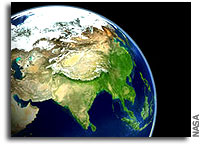NASA Details Earthquake Effects on the Earth

NASA scientists using data from the Indonesian earthquake calculated it
affected Earth’s rotation, decreased the length of day, slightly changed the
planet’s shape, and shifted the North Pole by centimeters. The earthquake that
created the huge tsunami also changed the Earth’s rotation.
Dr. Benjamin Fong Chao, of NASA’s Goddard Space Flight Center, Greenbelt, Md. and
Dr. Richard Gross of NASA’s Jet Propulsion Laboratory, Pasadena, Calif. said all
earthquakes have some affect on Earth’s rotation. It’s just they are usually
barely noticeable.
“Any worldly event that involves the movement of mass affects the Earth’s
rotation, from seasonal weather down to driving a car,” Chao said.
Chao and Gross have been routinely calculating earthquakes’ effects in changing
the Earth’s rotation in both length-of-day as well as changes in Earth’s
gravitational field. They also study changes in polar motion that is shifting the
North Pole. The “mean North pole” was shifted by about 2.5 centimeters (1 inch)
in the direction of 145 degrees East Latitude. This shift east is continuing a long-term
seismic trend identified in previous studies.
They also found the earthquake decreased the length of day by 2.68 microseconds.
Physically this is like a spinning skater drawing arms closer to the body
resulting in a faster spin. The quake also affected the Earth’s shape. They found
Earth’s oblateness (flattening on the top and bulging at the equator) decreased
by a small amount. It decreased about one part in 10 billion, continuing the
trend of earthquakes making Earth less oblate.
To make a comparison about the mass that was shifted as a result of the
earthquake, and how it affected the Earth, Chao compares it to the great Three-
Gorge reservoir of China. If filled the gorge would hold 40 cubic kilometers (10
trillion gallons) of water. That shift of mass would increase the length of day
by only 0.06 microseconds and make the Earth only very slightly more round in the
middle and flat on the top. It would shift the pole position by about two
centimeters (0.8 inch).
The researchers concluded the Sumatra earthquake caused a length of day (LOD)
change too small to detect, but it can be calculated. It also caused an
oblateness change barely detectable, and a pole shift large enough to be possibly
identified. They hope to detect the LOD signal and pole shift when Earth rotation
data from ground based and space-borne position sensors are reviewed.
The researchers used data from the Harvard University Centroid Moment Tensor
database that catalogs large earthquakes. The data is calculated in a set of
formulas, and the results are reported and updated on a NASA Web site.
The massive earthquake off the west coast of Indonesia on December 26, 2004,
registered a magnitude of nine on the new “moment” scale (modified Richter scale)
that indicates the size of earthquakes. It was the fourth largest earthquake in
one hundred years and largest since the 1964 Prince William Sound, Alaska
earthquake.
The devastating mega thrust earthquake occurred as a result of the India and
Burma plates coming together. It was caused by the release of stresses that
developed as the India plate slid beneath the overriding Burma plate. The fault
dislocation, or earthquake, consisted of a downward sliding of one plate relative
to the overlying plate. The net effect was a slightly more compact Earth. The
India plate began its descent into the mantle at the Sunda trench that lies west
of the earthquake’s epicenter. For information and images on the Web, visit:
http://www.nasa.gov/vision/earth/lookingatearth/indonesia_quake.html
For the details on the Sumatra, Indonesia Earthquake, visit the USGS Internet
site:
http://neic.usgs.gov/neis/bulletin/neic_slav_ts.html
For information about NASA and agency programs Web, visit:









